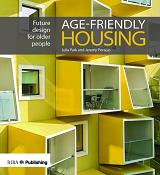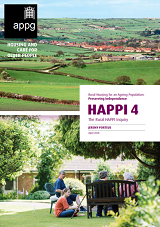Design Hub - Building homes and communities
These pages offer guidance and examples of effective design principles and practice in mainstream and specialist housing for older and vulnerable adults. From accessible and adaptable housing to age-friendly and inclusive design, there is also dedicated section that officially hosts all the HAPPI reports, including those written by the Housing LIN.
All the resources on these pages have been compiled to help architects, planners, builders, developers, commissioners, housing operators and occupational therapists better understand design accessible and adaptable homes and age-friendly communities. Along with the HAPPI section, they are split into ten main topics below.
Design Key Subjects
Accessible Design
This section enables you to access essential resources about lifetime homes and accessibility and adaptability - as well as case studies on accessible housing design and info on HoME – the Coalition for Accessible Housing.
Housing our Ageing Population Panel for Innovation (HAPPI)
This ‘go to’ section includes all the influential HAPPI reports, a selection of case studies and showcases other award winning developments inspired by the HAPPI design principles.
Inclusive Design
This section contains a selection of resources and other useful information to improve your understanding of universal and inclusive design and development in the built environment. It includes information about the Intersectional Stigma of Place-based Ageing (ISPA) project.
Designing Extra Care Housing
This section covers everything you need to know about designing extra care housing including Commissioning Extra Care or Funding extra care housing
Age-friendly communities and lifetime neighbourhoods
This section includes a range of key resources to help you learn more about the design and development of age-friendly communities, cities and neighbourhoods.
Eco/Sustainable Design
This section has a range of resources about eco-friendly developments and sustainable housing design that can improve the quality of life of older people.
Technology for our Ageing Population: Panel for Innovation (TAPPI)
TAPPI aims to provide you with the knowledge and tools to improve the way technology is used to support people living independently
Planning and design
This section has resources that will help you understand the implications of national and local planning policy. For more on planning homes and communities for older people, click on our Planning Portal.
Occupational Therapists input on the design of housing
These pages provide a range of learning and improvement services that show how occupational therapists can contribute to support commissioners, developers and providers create more inclusive environments for an ageing population.
Work Ready Housing
This section looks at 'work ready' design features, including the impact of Covid-19 to adapt existing or build new accessible homes to meet a growing need for people of all ages to work at/from home.
Key Resources
Adaptations Without Delay
This new RCOT report, written by the Housing LIN, is intended to be used by practitioners and organisations across the UK who may be contacted by disabled and older people and their families who are seeking advice or support with home adaptations
Age-friendly housing: Future design for older people
This essential RIBA publication, co-authored by Julia Park and Jeremy Porteus, investigates how we should approach the design of future housing for an ageing population.
Rural Housing for an Ageing Population: Preserving Independence (HAPPI 4)
An Inquiry established by the All-Party Parliamentary Group for Housing and Care for Older People has concluded that older people’s housing is neglected in rural areas. This report offers a number of 'rural proofing' recommendations to increase the quality, supply and range of more appropriate age-friendly housing.
Retirement Living Explained: A Guide for Design & Planning Professionals
Comprehensive guide by Churchill Retirement Living, supported by the Housing LIN, provides a fresh perspective on exactly how retirement living should be defined, getting to the heart of the changing needs and expectations for this niche sector of development.
Design Principles for Extra Care Housing
This Housing LIN Factsheet no 6 describes key design aims and principles and issues to consider when developing a brief for a new Extra Care scheme.
Housing our Ageing Population: Positive Ideas (HAPPI 3) - Making retirement living a positive choice
"Housing our Ageing Population: Positive Ideas" (HAPPI3), written by Jeremy Porteus, Director of the Housing LIN, calls for a significant change in the focus of Government policy away from solely concentrating on first time buyers, towards those in later life.
The Hidden Housing Market: A new perspective on the market case for accessible homes
New research report by Habinteg and Papworth Trust highlights the hidden housing market for 1.8m disabled people. Its findings clearly show the demand for accessible housing to rent and buy.
Designing with Downsizers: The next generation of 'downsizer homes' for an active third age
This report from The University of Sheffield DWELL Project (Designing for Wellbeing in Environments for Later Life) captures some of the findings from a three year research project co-produced with older residents in Sheffield.
Consultancy banner
Building on the Housing LIN’s learning and improvement ethos, we offer bespoke advice to help your organisation draw on the lessons highlighted on these pages. To find out how the Housing LIN can support your operational and/or strategic plans, please contact us at consultancy@housinglin.org.uk or visit our consultancy pages.
Latest Resources
- Housing LIN 2024-25 Year in Review
- Homes For All: A collective manifesto to end the housing emergency for everyone in Wales
- Age-friendly Town and Parish Guide
- A Roadmap for Independent Living: Reimagining Housing, Health, and Ageing in Scotland
- Independent Living, Intelligent Insight: The Role of Evercare in the Next Generation of TECS
- Planning Healthy Places: A guide for local authorities in Wales for embedding health in planning policy
- Forward Planning: A Vision of Ageing at Home
- Co-design Toolkit
- Launch of the Social and Affordable Homes Programme 2026 to 2036
- Trapped by Safety? Fire Doors, Accessibility and Policy Tensions in Housing









